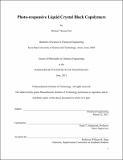Photo-responsive liquid crystal block copolymers/
Author(s)
Petr, Michael Thomas
DownloadFull printable version (14.49Mb)
Alternative title
Responsive liquid crystal polymers
Other Contributors
Massachusetts Institute of Technology. Dept. of Chemical Engineering.
Advisor
Paula T. Hammond.
Terms of use
Metadata
Show full item recordAbstract
Photo-responsive liquid crystal polymers (LCP) which contain azobenzene moieties have gained interest for their ability to change properties by merely irradiating them with the correct wavelength of light in the appropriate temperature range. Furthermore, they have been crosslinked for elasticity and to translate this property change into photo-mechanical actuation, such as contraction, expansion, bending, or oscillation. However, a major drawback and hindrance to their actual use as actuators has been their need for elevated temperatures and their slow responses at room temperature. The work described in this thesis addresses this problem, and its solution has an impact on the field of functional elastomers in general. To produce a fast photo-response at room temperature, a new photo-responsive azobenzene nematic side chain (SC) LC polysiloxane was developed, characterized, and demonstrated to respond significantly, and reversibly from 0-50°C, which is the ambient temperature range in which we live, through its photo-induced nematic to isotropic transition. In particular, its nematic phase almost totally disappeared in 35 s, and its modulus decreased up to 35% in about 10 s. To turn this photo-response into photo-actuation, polystyrene (PS) end blocks were added to the poly(vinylmethylsiloxane) (PVMS) to produce PS-b-PVMS-b-PS, which is important in and of itself because the PVMS has a very low Tg and a functionalizable backbone and the PS end blocks make the material a thermoplastic elastomer. After attachment of the azobenzene LC, the resulting photo-responsive thermoplastic elastomer reversibly contracted 3.3% against 25.7 kPa of stress in about 6 s.
Description
Thesis (Ph. D.)--Massachusetts Institute of Technology, Dept. of Chemical Engineering, 2012. This electronic version was submitted by the student author. The certified thesis is available in the Institute Archives and Special Collections. "June 2012." Cataloged from student-submitted PDF version of thesis. Includes bibliographical references (p. 100-108).
Date issued
2012Department
Massachusetts Institute of Technology. Department of Chemical EngineeringPublisher
Massachusetts Institute of Technology
Keywords
Chemical Engineering.